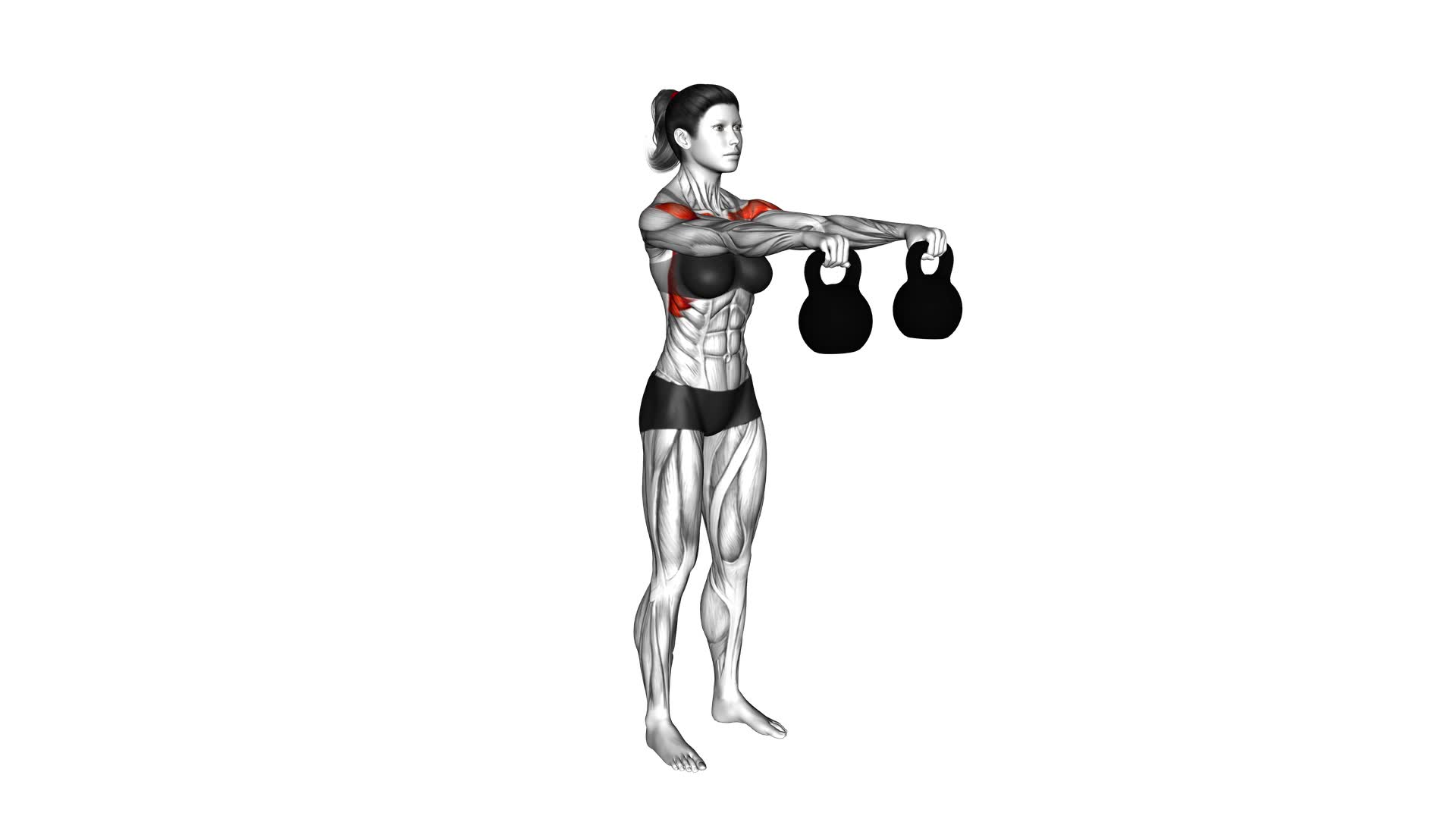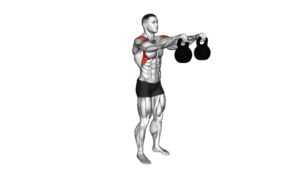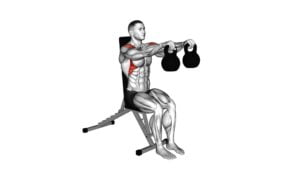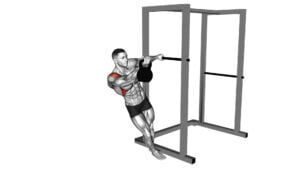Kettlebell Front Raise (female) – Video Exercise Guide & Tips

Incorporate the kettlebell front raise into your workout routine for a targeted and effective upper body exercise. This video exercise guide provides females with proper form, technique, and variations to maximize results.
Watch This Exercise Video
Avoid common mistakes and choose the recommended kettlebell weight for optimal performance. With precise execution and helpful tips, you'll reap the benefits of this challenging yet rewarding exercise.
Watch the video and get ready to sculpt your arms and shoulders like never before.
Key Takeaways
- Kettlebell front raise for females can increase shoulder strength and improve posture.
- It is important to use proper form and technique, including gripping the kettlebell firmly and maintaining a slight bend in the knees.
- Common mistakes to avoid include using too heavy of a kettlebell, swinging the kettlebell, and compromising the effectiveness of the exercise.
- When choosing a kettlebell weight, it is important to find the optimal weight that challenges without compromising form, considering individual strength and fitness level.
Benefits of Kettlebell Front Raise for Females
Discover the numerous benefits of performing the Kettlebell Front Raise exercise for females. This exercise is highly effective in increasing shoulder strength and improving posture. By regularly incorporating the Kettlebell Front Raise into your workout routine, you can achieve significant gains in both areas.
One of the key benefits of this exercise is the increased shoulder strength it provides. As you lift the kettlebell in a controlled manner, your shoulder muscles are engaged and forced to work against resistance. This leads to muscle growth and increased strength over time. Strengthening your shoulders not only enhances your overall upper body strength, but it also improves your ability to perform daily activities that require shoulder mobility and stability.
In addition to increased shoulder strength, the Kettlebell Front Raise also helps improve posture. This exercise targets the muscles in your upper back, including the rhomboids and trapezius muscles, which play a crucial role in maintaining proper posture. By strengthening these muscles, you can alleviate common postural issues such as rounded shoulders and forward head posture.
Transitioning into the subsequent section about proper form and technique for the Kettlebell Front Raise, it's important to ensure that you're performing the exercise correctly to maximize its benefits.
Proper Form and Technique for Kettlebell Front Raise
To ensure maximum benefits from the Kettlebell Front Raise exercise, it's important to focus on proper form and technique. Here are some key tips to help you perform this exercise correctly:
- Grip the kettlebell firmly with an overhand grip, keeping your palms facing down and your fingers wrapped around the handle.
- Stand with your feet shoulder-width apart, maintaining a slight bend in your knees and a neutral spine.
- Start with the kettlebell resting on your thighs and engage your core muscles.
- Slowly raise the kettlebell in front of you, keeping your arms straight and your shoulders down. Lift until your arms are parallel to the ground, or slightly higher.
By following these guidelines, you can ensure that you're performing the Kettlebell Front Raise with proper form and technique.
Remember, the benefits of this exercise for women include improved shoulder strength and stability, increased upper body muscle tone, and enhanced overall body coordination.
Additionally, there are various kettlebell front raise variations that you can incorporate into your workout routine to target different muscle groups and add variety to your training.
Common Mistakes to Avoid During Kettlebell Front Raise
Avoid these common mistakes to ensure proper form and technique during the Kettlebell Front Raise exercise. Proper technique is crucial for maximizing the benefits of this exercise and preventing injuries.
One common mistake to avoid is using too heavy of a kettlebell. It's important to start with a weight that you can comfortably lift and control throughout the movement. Using a weight that's too heavy can lead to poor form, making it difficult to properly engage the targeted muscles and increasing the risk of strain or injury.
Another mistake to avoid is swinging the kettlebell. This exercise should be performed with controlled and deliberate movements, focusing on lifting the weight using the shoulder muscles. Swinging the kettlebell not only compromises the effectiveness of the exercise, but it also puts unnecessary strain on the lower back and can lead to injury.
Lastly, make sure to maintain proper posture throughout the movement. Avoid rounding the shoulders or arching the back, as this can lead to strain in the neck, shoulders, and lower back.
Recommended Kettlebell Weight for Females
When determining the recommended kettlebell weight for females, there are a few key points to consider.
First, it's important to find the optimal weight that challenges you without compromising your form.
Additionally, take into account your individual strength and fitness level to choose a weight that's appropriate for your abilities.
Lastly, avoid using excessive weight that could lead to strain or injury.
Optimal Kettlebell Weight
Choose the appropriate kettlebell weight for optimal results in your female kettlebell front raise workout. Selecting the right weight is crucial to ensure you challenge your muscles without risking injury. Here are some guidelines to help you determine the optimal weight for your workout:
- Start with a lighter weight: If you're new to kettlebell training or have limited strength, begin with a lighter weight to focus on proper form and technique.
- Gradually increase the weight: As you gain strength and confidence, gradually increase the weight to continue challenging your muscles and progressing in your workouts.
- Aim for fatigue within the recommended rep range: The weight you choose should allow you to perform the recommended number of repetitions with proper form, while still feeling fatigued by the end.
- Listen to your body: Everyone's strength and capabilities are different, so pay attention to how your body feels during the exercise and adjust the weight accordingly.
Considering individual strength, it's important to choose a kettlebell weight that suits your current fitness level and allows you to perform the exercise safely and effectively.
Consider Individual Strength
To determine the recommended kettlebell weight for females, take into account your individual strength and choose a weight that challenges your muscles without compromising proper form or risking injury.
When considering individual strength, it's important to understand that everyone is different and what works for one person may not work for another. Strength training is a progressive process, so start with a weight that you can comfortably handle and gradually increase the weight as you become stronger. Remember, the goal is to challenge your muscles without overexerting yourself.
By choosing the appropriate kettlebell weight, you can ensure that you're getting the most out of your strength training routine.
Now, let's move on to the next section and discuss why it's important to avoid excessive weight.
Avoid Excessive Weight
Avoid using excessively heavy kettlebell weights when performing front raises as it can increase the risk of injury and hinder proper form. To ensure injury prevention and optimize the effectiveness of your workout, here are some discussion ideas and modifications to consider:
- Proper Technique:
- Focus on maintaining a neutral spine, engage your core, and avoid using momentum to lift the kettlebell.
- Keep your shoulders relaxed and your arms straight throughout the exercise.
- Injury Prevention:
- Start with a lighter kettlebell weight and gradually increase the load as your strength and technique improve.
- Listen to your body and stop if you feel any pain or discomfort.
- Modifications:
- If you find a kettlebell too heavy, you can use a dumbbell or even a water bottle as a substitute.
- This allows you to work on the proper technique without compromising form.
- Effective Exercises:
- In addition to kettlebell front raises, incorporate other exercises such as lateral raises, bent-over raises, and shoulder presses to target different muscles in your shoulders and arms.
- Variety is key for a well-rounded workout.
Variations and Progressions of Kettlebell Front Raise
Start with a single kettlebell and perform the kettlebell front raise exercise. Once you have mastered the basic movement, you can progress to different variations to challenge your muscles in new ways.
One variation is the double kettlebell front raise, where you hold a kettlebell in each hand and raise them simultaneously. This increases the load and works both arms simultaneously.
Another variation is the alternating kettlebell front raise, where you raise one kettlebell at a time, alternating between arms. This helps to improve coordination and balance.
You can also try the kettlebell front raise with rotation, where you rotate your torso as you raise the kettlebell, engaging your core muscles even more.
Additionally, you can experiment with different grips, such as the hammer grip or the pronated grip, to target different muscles in your shoulders and arms.
As you progress, you can increase the weight of the kettlebell or perform more repetitions to continue challenging yourself and building strength.
Remember to always maintain proper form and listen to your body to avoid injury.
Tips for Incorporating Kettlebell Front Raise Into Your Workout Routine
When incorporating the kettlebell front raise into your workout routine, focus on maintaining proper form and engaging your shoulder and arm muscles. This exercise is a great way to incorporate kettlebell exercises into your routine and reap the benefits of resistance training.
Here are some tips to help you get the most out of your kettlebell front raise:
- Start with a lighter kettlebell: It's important to choose a weight that challenges you but allows you to maintain proper form. Starting with a lighter kettlebell will help you focus on technique and prevent injury.
- Keep your core engaged: As you lift the kettlebell, make sure to engage your core muscles by pulling your belly button towards your spine. This will help stabilize your body and prevent any unnecessary strain on your lower back.
- Control the movement: Slowly raise the kettlebell in front of you, keeping your arm straight and your shoulder down. Avoid using momentum to lift the weight and instead focus on the controlled movement.
- Don't forget to breathe: It's easy to hold your breath during exercises, but remember to breathe throughout the movement. Inhale as you lower the kettlebell and exhale as you raise it.
Frequently Asked Questions
How Many Sets and Reps Should I Do for the Kettlebell Front Raise?
To determine how many sets and reps you should do for the kettlebell front raise, it's important to consider various factors.
Kettlebell front raise variations can target different muscles and intensities, so select the variation that suits your goals and fitness level.
As for the number of sets and reps, a common guideline is to perform 2-4 sets of 8-12 reps with proper form for the kettlebell front raise.
Remember to consult with a fitness professional for personalized recommendations.
Can the Kettlebell Front Raise Help Me Build Shoulder Muscle?
Yes, the kettlebell front raise can help you build shoulder muscle. By performing this exercise, you engage your anterior deltoids, which are responsible for raising your arms in front of you. This movement targets and strengthens your shoulder muscles, ultimately leading to increased muscle mass and definition.
While using dumbbells for front raises is also effective, kettlebells provide an added challenge due to their unique shape and distribution of weight. Additionally, alternative exercises to build shoulder muscles include overhead press, lateral raise, and upright rows.
Is the Kettlebell Front Raise Suitable for Beginners?
The kettlebell front raise can be a suitable exercise for beginners. To modify it for beginners, start with a lighter weight kettlebell and focus on proper form. Keep your core engaged and maintain a slight bend in your knees to avoid strain on your lower back.
Common mistakes to avoid include using too heavy of a weight and swinging the kettlebell instead of lifting it with controlled movements.
Should I Use a Heavier Kettlebell for the Front Raise to Build Strength or a Lighter One for Endurance?
To build strength, opt for a heavier kettlebell for the front raise. This will challenge your muscles and promote muscle growth.
On the other hand, using a lighter kettlebell will focus more on endurance, allowing you to perform more repetitions.
The kettlebell front raise is beneficial for women as it targets the shoulders, upper back, and core muscles. It helps improve posture, upper body strength, and stability.
Can I Incorporate the Kettlebell Front Raise Into My Upper Body Workout or Should I Do It on Its Own?
When incorporating the kettlebell front raise into your upper body workout, you'll experience several benefits.
This exercise targets your deltoids, upper back, and core muscles, improving overall upper body strength and stability.
By adding the kettlebell front raise to other exercises like push-ups or shoulder presses, you'll further challenge and engage these muscle groups.
This combination enhances your workout routine, allowing for a more well-rounded upper body training session.
Conclusion
Incorporating the kettlebell front raise into your workout routine can be a beneficial way for females to strengthen their upper body. By using proper form and technique, avoiding common mistakes, and selecting the appropriate kettlebell weight, you can effectively target and tone your shoulder muscles.
Additionally, by exploring variations and progressions of this exercise, you can continue to challenge yourself and make progress. Remember to consult with a fitness professional before starting any new exercise regimen.

Author
Years ago, the spark of my life’s passion ignited in my mind the moment I stepped into the local gym for the first time. The inaugural bead of perspiration, the initial endeavor, the very first surge of endorphins, and a sense of pride that washed over me post-workout marked the beginning of my deep-seated interest in strength sports, fitness, and sports nutrition. This very curiosity blossomed rapidly into a profound fascination, propelling me to earn a Master’s degree in Physical Education from the Academy of Physical Education in Krakow, followed by a Sports Manager diploma from the Jagiellonian University. My journey of growth led me to gain more specialized qualifications, such as being a certified personal trainer with a focus on sports dietetics, a lifeguard, and an instructor for wellness and corrective gymnastics. Theoretical knowledge paired seamlessly with practical experience, reinforcing my belief that the transformation of individuals under my guidance was also a reflection of my personal growth. This belief holds true even today. Each day, I strive to push the boundaries and explore new realms. These realms gently elevate me to greater heights. The unique combination of passion for my field and the continuous quest for growth fuels my drive to break new ground.







